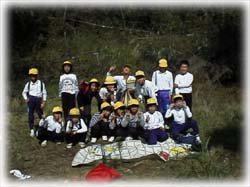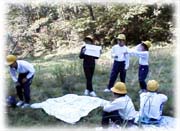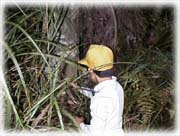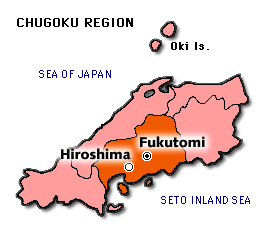Kuba Eco Club
 Forests cover around 70% of Fukutomi,
a town in Hiroshima Prefecture where Kuba Elementary School is located. Another
natural asset near the school is the Nuta River. The school also hosts the Kuba
Eco Club, a unique group whose wide-ranging program of environmental study is a part of the school's classes.
Forests cover around 70% of Fukutomi,
a town in Hiroshima Prefecture where Kuba Elementary School is located. Another
natural asset near the school is the Nuta River. The school also hosts the Kuba
Eco Club, a unique group whose wide-ranging program of environmental study is a part of the school's classes.
The club was launched in October 1997 by 16
fifth graders and their teacher, Akira Masuki. Club members get a lot more than
a chance to see nature up close. Environmental issues are taken up in the classroom
from a variety of angles, giving kids a fuller appreciation of the wonders of
nature and the complexity of environmental issues. Some 46 classroom hours were
devoted to Eco Club-related instruction during the 1997 school year.
 For instance, students learned during social
studies class that Japan's rapid industrial development produced a great deal
of pollution. They also studied how automobile exhaust affects the environment
and learned about the efforts being made to reduce air pollution.
For instance, students learned during social
studies class that Japan's rapid industrial development produced a great deal
of pollution. They also studied how automobile exhaust affects the environment
and learned about the efforts being made to reduce air pollution.
In Japanese class, meanwhile, students read a
passage about environmental problems and discussed what they thought about it
with their classmates. And in art class, kids made posters conveying the importance of protecting nature.
 Kids gained a deeper understanding of the environmental
issues they learned about in the classroom through first-hand contact with nature.
They made scientific observations of how clean the Nuta River was by collecting
living organisms from it and looking up illustrated reference books to see if
they were found in clean or dirty rivers.
Kids gained a deeper understanding of the environmental
issues they learned about in the classroom through first-hand contact with nature.
They made scientific observations of how clean the Nuta River was by collecting
living organisms from it and looking up illustrated reference books to see if
they were found in clean or dirty rivers.
They also strolled through the woods near the
school, playing "cards" with the leaves of different trees and creating "sound
maps" by indicating where they heard the cries of birds and insects. They also
applied stethoscopes to tree trunks to hear their "heart beat" (you can actually
hear the trees sucking up water!). The chance to play with natural "toys" like
the cast-off shells of cicadas and nuts of various kinds gave members a new awareness
of the forest.
 "Even
though the club is just for fifth graders," the teacher Mr. Masuki said, "kids
who were members last year still remember what they've learned. They've told me,
for instance, that they're paying more attention to the litter on the streets."
"Even
though the club is just for fifth graders," the teacher Mr. Masuki said, "kids
who were members last year still remember what they've learned. They've told me,
for instance, that they're paying more attention to the litter on the streets."

 Forests cover around 70% of Fukutomi,
a town in Hiroshima Prefecture where Kuba Elementary School is located. Another
natural asset near the school is the Nuta River. The school also hosts the Kuba
Eco Club, a unique group whose wide-ranging program of environmental study is a part of the school's classes.
Forests cover around 70% of Fukutomi,
a town in Hiroshima Prefecture where Kuba Elementary School is located. Another
natural asset near the school is the Nuta River. The school also hosts the Kuba
Eco Club, a unique group whose wide-ranging program of environmental study is a part of the school's classes.  For instance, students learned during social
studies class that Japan's rapid industrial development produced a great deal
of pollution. They also studied how automobile exhaust affects the environment
and learned about the efforts being made to reduce air pollution.
For instance, students learned during social
studies class that Japan's rapid industrial development produced a great deal
of pollution. They also studied how automobile exhaust affects the environment
and learned about the efforts being made to reduce air pollution.  Kids gained a deeper understanding of the environmental
issues they learned about in the classroom through first-hand contact with nature.
They made scientific observations of how clean the Nuta River was by collecting
living organisms from it and looking up illustrated reference books to see if
they were found in clean or dirty rivers.
Kids gained a deeper understanding of the environmental
issues they learned about in the classroom through first-hand contact with nature.
They made scientific observations of how clean the Nuta River was by collecting
living organisms from it and looking up illustrated reference books to see if
they were found in clean or dirty rivers.  "Even
though the club is just for fifth graders," the teacher Mr. Masuki said, "kids
who were members last year still remember what they've learned. They've told me,
for instance, that they're paying more attention to the litter on the streets."
"Even
though the club is just for fifth graders," the teacher Mr. Masuki said, "kids
who were members last year still remember what they've learned. They've told me,
for instance, that they're paying more attention to the litter on the streets."